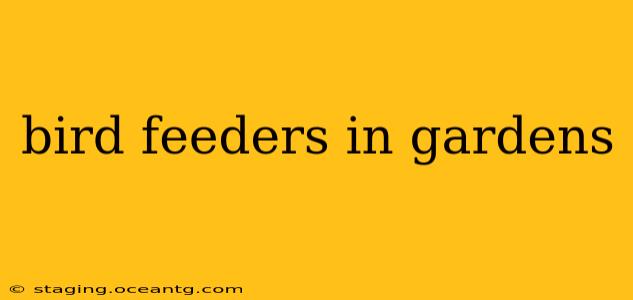Bird feeders are a delightful addition to any garden, bringing a vibrant splash of color and lively activity. They offer a fantastic opportunity to observe diverse bird species up close, fostering a deeper connection with nature right in your backyard. But choosing and placing the right feeder requires some consideration. This guide will explore the best types of bird feeders for gardens, placement strategies, and how to create a bird-friendly environment that encourages regular visits.
What are the different types of bird feeders?
There's a wide variety of bird feeders available, each designed to attract specific types of birds. Understanding these differences helps you choose the best option for your garden and the birds you hope to attract.
- Tube Feeders: These are popular choices, featuring multiple feeding ports and usually holding seeds. They're relatively easy to clean and refill.
- Hopper Feeders: Larger capacity feeders with a covered hopper, often offering protection from the elements and deterring squirrels.
- Platform Feeders: Simple, open platforms that offer easy access for a variety of birds, including those that prefer to feed on the ground. These are also great for suet.
- Suet Feeders: Specifically designed for suet cakes or balls, a high-energy food source particularly appealing during colder months.
- Window Feeders: These attach to your window, providing close-up viewing opportunities. However, ensure they are safely positioned to avoid collisions.
What type of birdseed is best for a garden bird feeder?
Different birds prefer different types of seeds. Offering a variety ensures you attract a wider range of species.
- Sunflower Seeds (black oil): A favorite among many birds, offering high energy and easy accessibility.
- Nyjer Seeds (thistle): Small seeds that attract finches and goldfinches. Use feeders specifically designed for these tiny seeds.
- White-striped Sunflower Seeds: Larger than black oil sunflower seeds, attracting larger birds like cardinals and jays.
- Milo: A less expensive option, but less popular with some birds.
- Mixed Seeds: Convenient blends, but often contain fillers less appealing to birds. Choose a high-quality mix with a good proportion of preferred seeds.
How do I keep squirrels away from my bird feeder?
Squirrels can be notorious for raiding bird feeders. Here are some strategies to deter them:
- Squirrel-resistant feeders: These feeders feature cages or baffles that prevent squirrels from reaching the seeds.
- Strategic placement: Place feeders away from trees and other structures that squirrels can use to jump onto the feeder.
- Slippery poles: Mount feeders on smooth poles or metal pipes, making it difficult for squirrels to climb.
- Other Deterrents: Consider using commercial squirrel repellents (following the instructions carefully), or even strong-smelling herbs around the feeder base.
Where is the best place to put a bird feeder in my garden?
Proper placement is crucial for attracting birds and ensuring their safety.
- Visibility: Place feeders in a location where birds can easily see them from a distance, but also offers some cover for protection from predators.
- Shelter: Choose a spot that offers some protection from harsh weather, such as rain, snow, or strong winds.
- Predator Protection: Avoid placing feeders too close to bushes or trees that could harbor predators.
- Accessibility: Ensure the feeder is easily accessible for filling and cleaning.
How often should I clean my bird feeder?
Regular cleaning is essential for maintaining bird health and preventing the spread of disease.
- Frequency: Clean your bird feeder at least once a month, or more frequently in warmer, humid weather.
- Cleaning Process: Wash the feeder thoroughly with soap and water, then rinse completely and allow it to air dry completely before refilling.
By following these guidelines, you can create a welcoming and thriving bird habitat in your garden, enjoying the beauty and wonder of these fascinating creatures up close. Remember to observe the birds in your area and tailor your feeder choice and seed selection to best cater to their needs. Happy birding!
